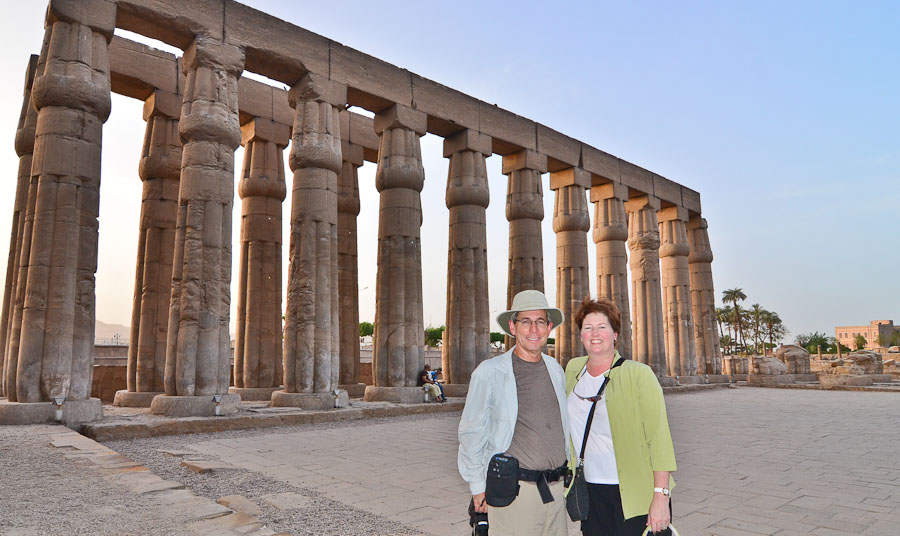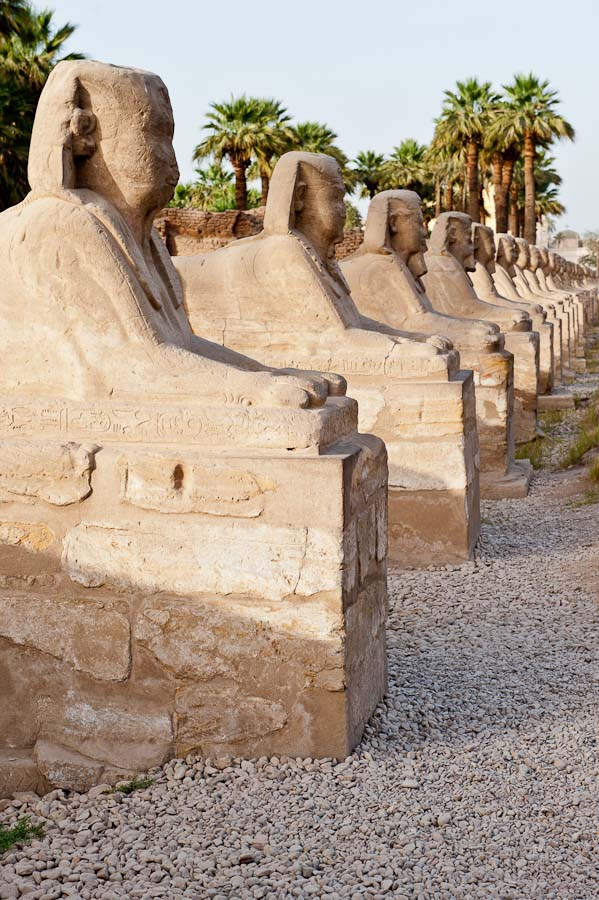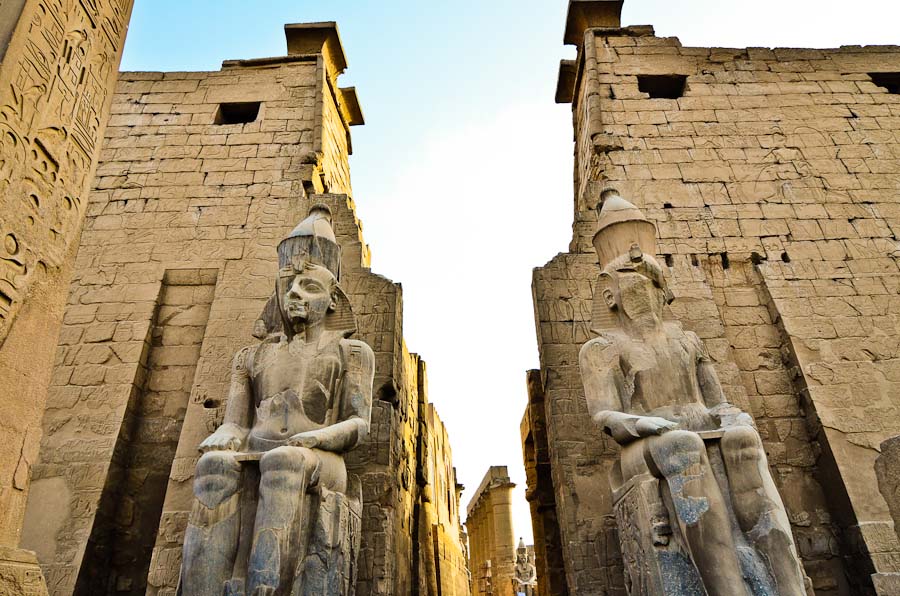We leave the ship today for an overnight trip to Luxor, Egypt. Our bus joined the group of coaches with a guarded escort to make the 3 ½ hour drive to Luxor from the port of Safaga.
Click here for the April 6th People Picture Gallery.
Click here for the April 6th Antiquities Picture Gallery.
Click here for the April 7th People Picture Gallery.
Click here for the April 7th Antiquities Picture Gallery.
As this is our first stop in Egypt, we’ll provide a little background information. Egypt is located at the northeast corner of the African continent surrounded by Syria, Israel, Jordan, Saudi Arabia, Sudan and Libya. It’s political history, including what is happening here currently, is complex and often violent. They’ve had a turbulent history both with outside invaders as well as multiple civil wars.
This is one of the most ancient places on earth. Civilization started around 10,000 BC (although some say 25,000 BC) and the 1st Dynasty of Kings started around 3,100 BC. The most well known pharaohs are King Tut-ankh-amen (King Tut) and Ramses. It turns out there were actually 11 Pharaohs named Ramses …the one from the time of Moses was supposedly Ramses II.
The Nile River runs the length of Egypt and it is the longest river in the world. It is over 4,000 miles long – stretching from the Mediterranean Sea all the way through the African continent. The source of the Nile River are its’ two primary tributaries, the Blue Nile and the White Nile. The existence of the Nile River is the primary reason Egypt has risen to power and prestige throughout history.
An interesting fact about Egypt is that they have approximately 23 million land mines buried in the western part of the country. The area along the north coast was mined between 1940 and 1943 involving Britain and its allies (including Egyptian forces) fighting German and Italian forces for control of North Africa. The areas to the east, including the Sinai Peninsula were mined between 1956 and 1973 due to hostilities between Egypt and Israel. Mined areas represent 22% of the total surface of Egypt.
Our first stop in Luxor was the Luxor Temple. The city of Luxor, home to approx. 500,000 people, was known as the ancient city of Thebes, was founded in 1,400 BC. For centuries Thebes was the capital of the known world. This area is basically an open-air museum, with temples located in the middle of the city. It’s strange driving along city streets and going past ancient temples and columns. The Luxor Temple was built by a king called Amenophis III and later expanded by Ramses II.
Next we went to check-in at our hotel, the Sonesta Luxor, which has the most high-tech bathroom we’ve ever seen! The shower was like a space ship and the toilet was more complicated than any other I’ve seen!
Back on-board the coaches we went to see the light and sound show at the Karnak Temple. This temple is extensive and it was impressive to see it at night…although it was dangerous (to say the least) because the ground is uneven and there are rocks and things that can trip you everywhere!
The show took us through the main part of the temple and gave us the history of the area. We ended up in a large, open theatre where we got the rest of the story and were treated to a beautiful full moon.
After the show we took the buses back to the hotel where we had a nice buffet dinner outside in an area on the bank of the Nile.
The following morning we were up at 7:00 am for a quick buffet breakfast and in the buses again by 8:00 am. Paul and Kathy were also in Cairo on a private tour and Paul had invited us to join him on a hot air balloon ride he was doing. We opted not to go a.) we’d have to get up at 4:00 am and could possibly miss our day with the organized group; and b.) Judy and Franco had done this before in Luxor and had a bit of a challenge with their hot air balloon “crashing” (they weren’t hurt).
So instead, we joined the group and crossed the Nile to the west bank to visit the Valley of the Kings. The early Egyptians always buried their dead on the west side of the Nile as they believed life was created from the east and death follows to the west.
The Valley of the Kings is situated under a naturally occurring pyramid shaped mountain and is home to 62 Tombs, all deep underground, dug into the limestone hillside in Qurna. The most famous tomb discovered here is that of King Tut. The reason it is famous is because it wasn’t found until 1922 and it is one of the only tombs found completely intact. Most Tombs were robbed over thousands of years with few remnants.
There were LOTS of persistent peddlers and it was amazing, when you ignore them, how quickly their price would fall from $100 dollars to $10 dollars! We found out that the stuff they sell at these tourist locations is primarily made in China.
Next we did a photo stop at Queen Hatshepsut’s Temple and then a drive-by of Medinet Habu and Colossi of Memnon. After, we made our way back to the hotel to have lunch and check-out and then we were back at the Karnak temple to visit it during the day. This is one of the most impressive temples we’ve seen. It is a massive complex of ruined temples, chapels and other buildings of various dates. The area was built over 2,000 years by various kings with each one adding on and making bigger and better improvements.
During the Egyptian Revolution of 2011, there were rumors that attacks were planned against monuments including Karnak Temple. This prompted authorities to erect barriers and guard it with tanks. Luckily no damage was done in Luxor, although the Egyptian Museum in Cairo was attached and some damage was done inside that building.
You see a lot of hieroglyphics throughout the tombs and temples. I didn’t realize that in 1799 a key was found in Northern Egypt that led to the translation of hieroglyphics. This key is called the “Rosetta Stone”. The stone shows three scripts: the upper text is Ancient Egyptian hieroglyphs, the middle portion Demotic script, and the lowest Ancient Greek. Because it presents essentially the same text in all three scripts, it provided the key to the modern understanding of Egyptian hieroglyphs. The original stone came into British possession under the Capitulation of Alexandria. Transported to London, it has been on public display at the British Museum since 1802. It is the most-visited object in the British Museum.
Luxor is filled with loads of interesting stuff…by the end of the 2nd day visiting tombs and temples our heads were full and we were happy to once again be back on-board the Voyager.



.jpg)



Cheryl - Love the photo of Margaret and the back ground. I want to be able to take a photo like that penguin! Beautiful
Cheryl - I’ve been meaning to ask you. Do you take notes or how do you remember everything you share. So much information and so interesting. How do you take photos and focus on all the information you are taking in? So interesting. Thanks for all of your hard work posting this information.
Wayne - You have to love a guy with a two donkey powered cart. Some guys have everything. Is Donkey power better than horse power?